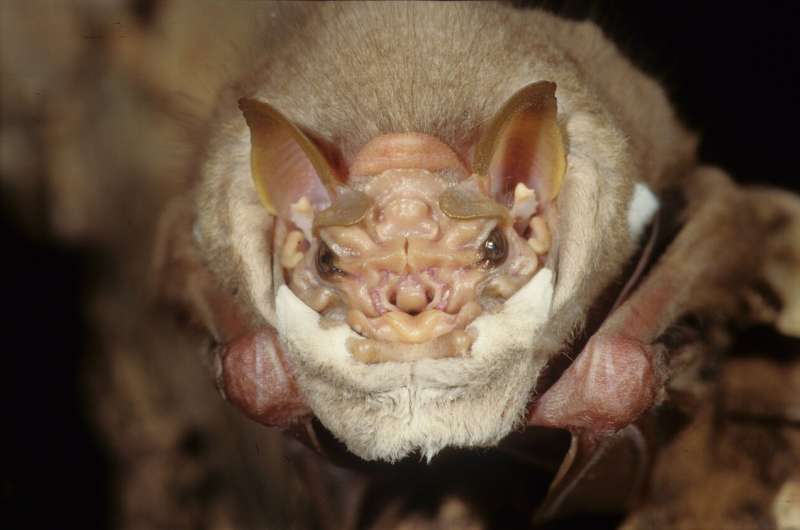First sightings of lek and courtship behavior in wrinkle-faced bats

Wrinkle-faced bats not only have the most convoluted faces of any bat species, the males also have a flap of furry white skin they can pull over their lower faces, not unlike the face masks people wear. In a new report published in PLOS ONE, Smithsonian researchers and colleagues describe the first observations of courtship in this species.
"This was an incredibly lucky encounter with these rarely observed 'masked seducers,'" said Marco Tschapka, a research associate at the Smithsonian Tropical Research Institute from the University of Ulm.
In September 2018, on a night walk in San Ramon, Costa Rica, two nature guides noticed several "ugly" bats hanging from some low branches near a trail. They called friends who know about bats, who, in turn, called their professor, Bernal Rodríguez-Herrera at the University of Costa Rica.
"Most people think all bats are ugly, so I didn't take the report very seriously at first, but when they sent photos, we realized that these animals were wrinkle-faced bats, Centurio senex, an incredible find," Rodríguez said. "Not only is this a rare bat species that a lot of bat researchers would love to have on their life lists, these bats were doing something that no one had ever seen before."
Rodríguez called Tschapka, who happened to be leading a field course in Costa Rica. Tschapka jumped at the chance to join the project led by Rodriguez-Herrera and to see not only one, but many wrinkle-faced bats together.
"We would never have expected to see these bats in San Ramon," Tschapka said. "Their range extends from Mexico to Colombia and Venezuela, but we hardly ever catch them in our nets. If I were desperate to find one, I would probably go to the dry, lowland forest in northwest Costa Rica, but never to a cloud forest."
The bats perched close together in a relatively small area, hanging from trees and shrubs only about 2.35 meters (around 8 feet) off the ground. They were all males, easily recognizable by the obvious face mask that is only present in adult males, never in females. Every evening, the bats started to occupy their perches at about 6 p.m. By midnight, they had disappeared again.
Soon the team suspected that this incredible find was in fact a group of males showing off to a female crowd. They recorded bat behavior with a hand-held, infrared-sensing video camera and made sound recordings using an ultrasound microphone connected to a computer. Males perched with their masks pulled up over their faces spent most of their time twiddling their wing tips and emitting ultrasonic echolocation calls, now and then interspersed with longer trill song sequences.
But when another bat approached, a singing male would get very agitated, began to beat his wings together, and finally end his display by thrusting his body forward toward the visitor while making a loud, audible whistle.
"I wish I could have been there," said Gloria Gessinger, a Smithsonian fellow who analyzed the bat sounds at the University of Ulm in Germany. "In the video recordings you can hear them whistling all around the forest from different distances. It sounds so amazing!" Gessinger discovered that the echolocation calls in these bats are very unique, consisting only of the fundamental frequency, but without the multiple harmonic overtones typical for other species of leaf-nosed bats.
On Oct. 10, the team recorded two wrinkle-faced bats mating for the first time.
"A female obviously could not resist the seductive calls of one of the masked singers any longer," Tschapka said. "She joined the perching male and quickly they dedicated themselves to their private business, thus confirming our idea that the males were there to attract females."
During a six-week period, the team observed a total of 53 perches. The greatest number of bats present at any one time was 30 in early October, and then their numbers dwindled. By Oct. 31, there were no bats left at the site.
This aggregation of bats shows all of the characteristics of lek mating, a system in which many males gather together to display for females. Some of the most famous examples of lekking animals are birds such as manakins and grouse. This type of courtship behavior has only been observed in a few bat species.
Now the team has more questions than answers. Because the lek they found was the first reported, they chose not to capture bats at the site for fear of scaring the animals away. So, they still cannot be sure whether most of the visiting bats were females or whether males also visited their perched rivals. It would be extremely revealing to record the behavior of the quick-moving visiting bats with a high-speed camera.
Also, the exact role of the curious face mask is still unclear—perhaps the skin fold offers some sort of protection or is the origin of an irresistible perfume attracting the females. To find out, it would be necessary to capture courting males as they gather in a lek.
This rare sighting was two years ago, and the bats have not been back.
"Last year, I had my suitcase packed and ready to go...but...nothing," Tschapka said. "We think that these bats are nomads, they move around a lot, and we may never get to see this behavior again in our lifetimes. But who knows? We are definitely on the lookout!"
More information: Rodríguez-Herrera, B., Sánchez-Calderón, R.. Madrigal-Elizondo, V., et al. 2020. The masked seducers: Lek courtship behavior in the wrinkle-faced bat Centurio senex (Phyllostomidae). PLOS ONE (2020). journals.plos.org/plosone/arti … journal.pone.0241063
Journal information: PLoS ONE
Provided by Smithsonian Tropical Research Institute




















